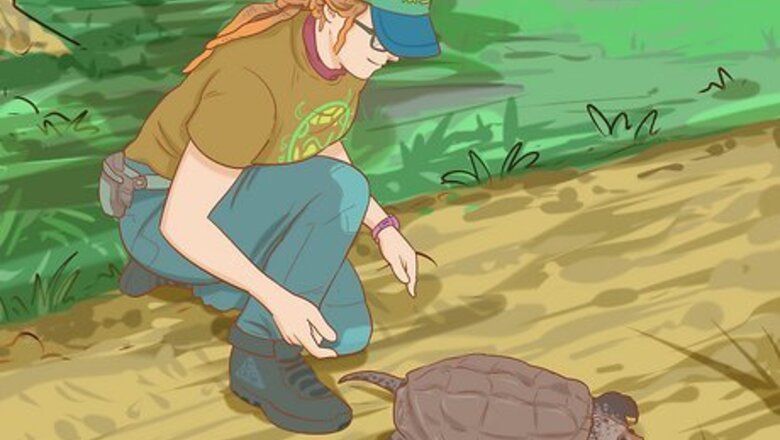
views
Picking Up an Adult Snapping Turtle
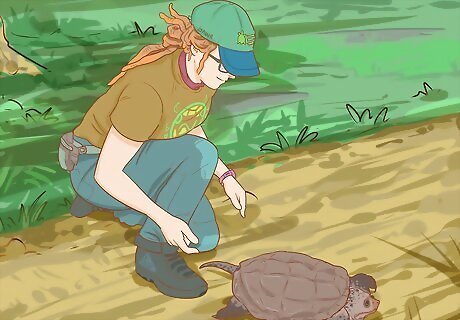
Approach the snapping turtle from behind. A snapping turtle has a super powerful bite—it won’t let go easily and its beak is designed to crush prey. Do what you can to limit the turtle's opportunity to snap at you while you're reaching down to help. Walk slowly towards the turtle, carefully avoiding its line of vision (and as you get close, its powerful jaws!). Make as little noise as possible while you approach the turtle. On land, this animal stays super alert to its surroundings. You don't want to spook the turtle before you reach it.
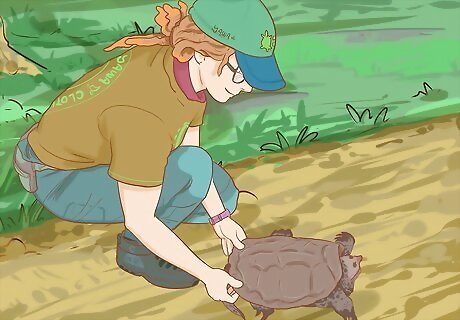
Hold the turtle with your thumbs on the top shell and fingers on the bottom shell. Grip the turtle on the top of its shell, just above each of its back legs—like you're holding a tray of food with two hands. This will help you handle the turtle's weight without getting in range of its strong jaws. The turtle's neck can reach much farther back than you'd think. Snappers' claws can be incredibly sharp, too, so if possible, protect your hands and arms with gloves, a t-shirt, or a towel. When lifting, hold the turtle as low to the ground as possible. This way, you’ll limit any potential injury to the animal. Keep the turtle’s head pointed away from you at all times to avoid injury. Never grab an adult snapping turtle anywhere besides the back half of its shell. This includes the turtle’s tail!
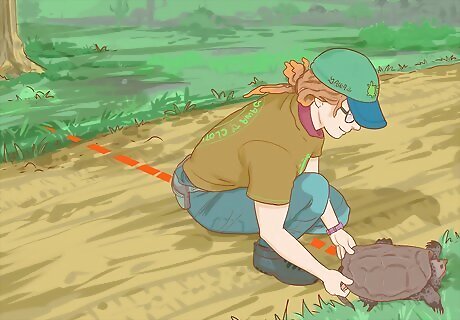
Set the snapping turtle down in a safe location. If you find a turtle in the middle of the road, set it down on the opposite side of the street, moving the animal in the same direction it was already headed. Turtles already have a great sense for direction, so the best thing you can do for the animal is to simply move it past the danger area—but not change its course. Wherever the turtle is headed, it knows where it's going! If there’s a water source nearby, it may seem like the turtle must be headed in that direction. Don’t assume this, and don’t set the turtle in or near the water. Take it no farther than the opposite side of the road. If you've incorrectly identified the turtle species or the turtle has an injury you're unaware of, putting it in water could be extremely dangerous. Once you set the adult snapping turtle down, move back quickly. The animal will likely be on the defense and ready to snap. You don’t want to be within range of that bite once you set the snapper free!
Picking Up a Baby Snapping Turtle
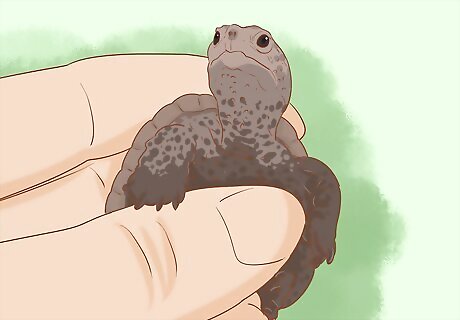
Lift the turtle with your pointer finger and your thumb. Place your forefinger under the turtle and between its rear legs. Place your thumb on the top of the shell, near to the rear legs. Gently grab the turtle from this position and lift. Be sure not to get too close to those tiny (but powerful!) jaws. This hold should be like a pinching motion. You'll pick up the baby in the same way you might pluck a cookie from a plate (only much more carefully, of course!).
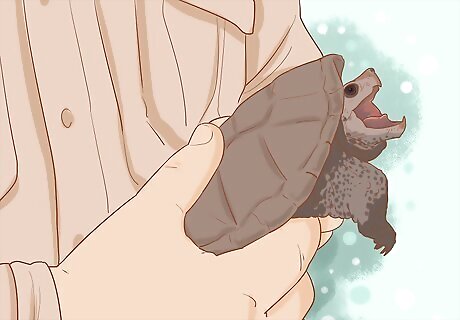
Hold larger, juvenile snapping turtles like a sandwich. As the turtle starts to grow on from infancy, it'll reach the juvenile stage—at this point, it'll be up to 5 inches (0.42 ft) long. When the snapper is around this size, use at least two fingers from both hands. Lift with your pointer (and middle, if needed) under the turtle and your thumb on top of the shell.
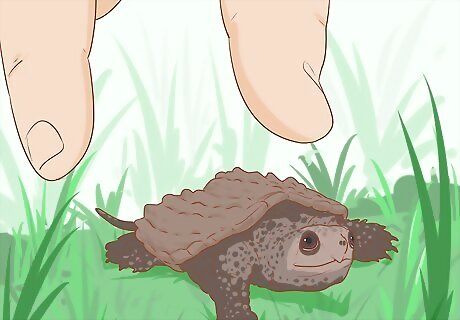
Set the baby snapping turtle down in a safe location. If you find the turtle crossing the street, your aim may be to keep it safe from oncoming traffic. Lift the turtle all the way across the road and set it on the opposite side of the street. When you do this, be sure to keep the turtle headed in the same direction that it was already walking in. The baby was traveling that way for a reason! Don't bring the animal to a nearby water source, even if it seems like this must be where it was headed.
Identification, Injury Assessment, & Safe Relocation
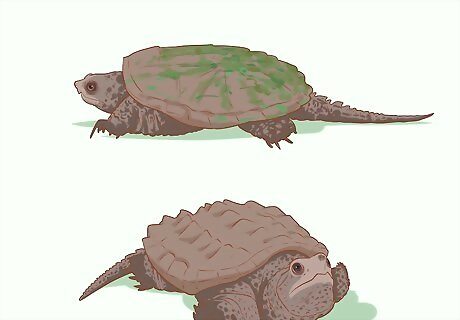
Look for moss-covered turtles with long tails. Both snapping and alligator snapping turtles will sport a dark brown, green, grey, or black shell, and will likely be covered in algae or moss—so look out for those two common signs. Then, check out the turtle's tail. When you’re dealing with a snapper, that'll be a dead giveaway; its tail will be extremely long, usually equaling the shell's length. A baby turtle will be just a few inches long. But still, it'll sport the same staples: long tail, dark shell, and sharp claws. An alligator snapping turtle will also have 3 ridges on its shell (called keels) and may look sort of prehistoric at first glance. Then, it'll have a triangular jaw. Common snapping turtles, on the other hand, have a smooth shell and a softer, u-shaped jaw. Both species are large, but alligator turtles are larger. Alligator snappers range from 50–220 pounds (23–100 kg), and common snappers, 20–35 pounds (9.1–15.9 kg). Never attempt to lift a turtle that you're not entirely sure you could carry safely. You’ll risk injury to yourself and the animal.
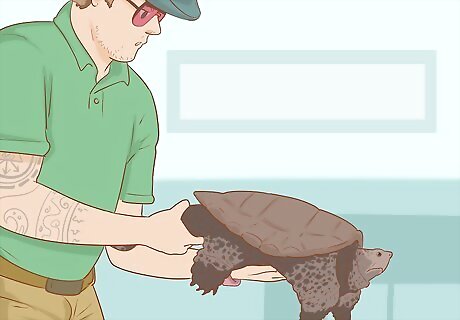
Check the snapping turtle for injuries. With adult turtles, observe from a distance. Look for signs that the adult snapping turtle might be injured—this might be poor movement, a shell injury, a broken limb, or you may notice blood. If you suspect that the animal is injured and plan to take the turtle to a wildlife rescue center, make sure to record your exact location so the center can return the snapping turtle when it's all better. Note that a turtle's injuries can be worse than they seem—if you’re concerned and are in a position to help safely, take the animal in to get a professional's opinion.
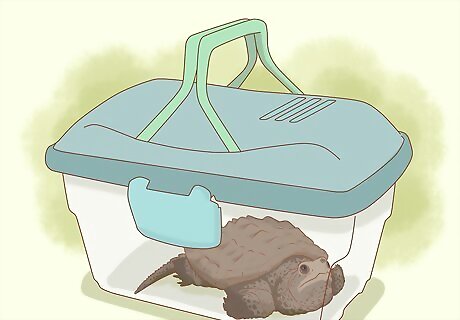
Take the injured turtle to a wildlife rescue center. If the snapper is injured, gently place the turtle in a carrier with ventilation, a tight lid, and a towel on the floor to prevent slipping. If you're getting the turtle into a carrier, have another person shut the door behind the turtle as you set it inside. This will limit the chance of injury. While you're traveling, avoid sounds, handling, providing first aid, or providing a heat source for the turtle. This will help keep its stress levels low. For baby snapping turtles, it’s less important to make sure your box has a tight lid. Note that a smaller container (like a shoe box) would suit as well.



















Comments
0 comment